Amazing imperial cities of morocco
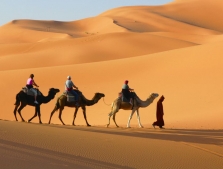
Program
- Day 1 :
Casablanca / Rabat
Arrival at Mohammed V Airport in Casablanca.
Welcome & assistance
Departure to Rabat
Dinner and accommodation at the hotel.
- Day 2 :
Rabat/Chefchaouen
Breakfast at the hotel.
Visit of Hassan Tower and Mohamed V Mausoleum then continue to Chefchaouen as it is often called by Moroccans. It was founded in 1417 by Moorish and Jewish refugees who fled from Spain.
Free lunch, then visit of the medina of Chefchaouen with its narrow winding lanes and its various shades of blue.
Dinner and accommodation at the hotel in ancient medina.
- Day 3 :
Chefchaouen/Fez
Breakfast at the hotel.
Departure to Fez, Imperial City, dated back to the eighth century. Free lunch,
visit medieval medina of Fez classified as World Heritage by UNESCO visit the
fabrication of leader and bronze, the Nejjarine Square. You will also see from outside the Mausoleum of Idriss II and the fabulous Quaraouine mosque. Then visit of Royal palace gate of fez and Fes El jdid (new city).
Dinner and accommodation at the hotel.
- Day 4 :
Fez/Ifrane/Erfoud /Merzouga
Breakfast at the hotel.
Early departure (in order to enjoy the sunset in Merzouga) for Midelt through the mountains and the cedar woods of the middle Atlas. You will pass by Ifrane, a charming ski resort. Short stop to take photos with the lion statue and continue via Azrou an important handicraft centre specialised in the work of cedar wood. After the Zad pass (2,178m), you will arrive in Midelt for free lunch then continue to Merzouga via Erfoud, an oasis town in the Sahara Desert. Merzouga is known worldwide for its sunrise and sunset, its luminosity and very pure landscapes. A camp is set up around a campfire where you can have camel riding (45 min maximum) to enjoy the sunset then a traditional Berber dinner.
- Day 5 :
Merzouga/Tinghir/Boumalne Ddades /Ouarzazate
Breakfast at the hotel, then drive to Ouarzazate via Tinghir one of the most important cities in south Morocco. Arrival to the spectacular Gorges of Todra, canyon in the eastern part of the High Atlas.
Free lunch
Continue on to reach Ouarzazate via Boumalne dades and Kelaa M'gouna (Valley of the Roses)
Dinner and accommodation at the hotel.
- Day 6 :
Ouarzazate /Ait Ben Haddou/Marrakech
Breakfast at the hotel.
Optional visit of the Kasbah Taourirt, considered to be one of the most impressive structures of its kind. Departure to Marrakech via the Kasbah town of Ait Ben Haddou which, at a height of 1,160m, stands in stark contrast to this vast plateau. Originally a crossing point for traders crossing the Sahara Desert, this UNESCO world heritage site is equally recognized as the location for films such as ‘Laurence of Arabia’ and ‘Gladiators’. Visit to the Kasbah and the fortified village. Continue to Marrakech via Tizin Tichka , peaking at 2260 meters, one of the most beautiful roads in Morocco that offers a magnificent view of pure and mixed nature.
Dinner and accommodation at the hotel.
- Day 7 :
Marrakech
Breakfast at the hotel,
You will start a historical visit of the principal monuments of Marrakech. You will stop before the famous Koutoubia, a demonstration of Hispano-Moorish art that has a 70m minaret, The Bahia palace ( fees not included) decorated with exceptional cedar wood and The Saadians tombs (fees not included), date back from the time of the sultan Ahmed al Mansour (1578- 1603). The tombs were only recently discovered (in 1917) and were restored by the Beaux-arts services.
Free lunch, visit of the souks sources of temptations, regrouping
different works and business: Cabinetmakers, ironware merchants, boiler makers.
Then the visit continues to the famous Jamâa El fna square known to be a place of public execution until last century. Today it provides constant ever changing entertainment, which is more alive in the sunset and continues late in the night. The square is centre for public meetings and even riots, where story tellers, snake charmers, acrobats, folkloric bands, etc... are operating daily.
- Day 8 :
Marrakech/Casablanca
Breakfast at the hotel. Departure to Casablanca. Free lunch.
Exterior visit of Hassan II Mosque, is the largest mosque in Africa, and the 5th largest in the world then visit of the Mohammed V Square, one of the most famous landscapes.
Dinner at a restaurant and accommodation at the hotel
- Day 9 :
Casablanca
Breakfast at the hotel, Transfer to airport for the flight of your return
Included in the price: Welcome and assistance 4* Hotel accommodation in double occupancy 8 breakfast and 7 dinners at the hotel 1 dinner in a restaurant outside the hotel English speaking tour guide Tour in air conditioned vehicle according to number of guests 4X4 and camel ride in Merzouga dunes Not included : beverages, monument entrance fees, travel and medical insurances, tips, extra...
Booking information of the package tour
Date of departure : 2020-04-27
Gallery
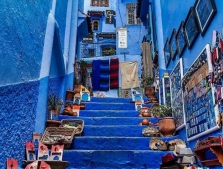
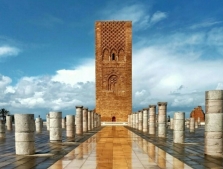
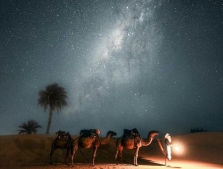
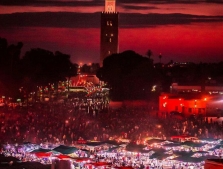
 If you already have an account, please login clicking here.
If you already have an account, please login clicking here.